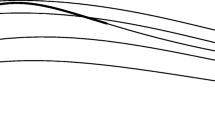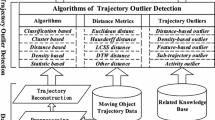Abstract
With the development of science and technology and the explosive growth of data, there will be a lot of trajectories every day. However, how to detect the abnormal trajectory from many trajectories has become a hot issue. In order to study trajectory anomaly detection better, we analyze the Sequential conformal anomaly detection in trajectories based on hausdorff distance (SNN-CAD) method, and propose a new measurement method of trajectory distance Improved Moved Euclidean Distance (IMED) instead of Hausdorff distance, which reduces the computational complexity. In addition, we propose a removing-updating strategy to enhance the conformal prediction (CP). Then, we also put forward our Non-conformity measure (NCM), Mean Distance Deviation. It can enlarge the difference between trajectories more effectively, and detect the abnormal trajectory more accurately. Finally, based on the technical measures mentioned above and under the framework of enhanced conformal prediction theory detection, we also build our own detector called Mean Distance Deviation Detector (MDD-ECAD). Using a large number of synthetic trajectory data and real world trajectory data on two detectors, the experimental results show that MDD-ECAD is much better than SNN-CAD in both accuracy and running time.
This work has been funded by Natural Science Foundation of China under Grants No. 61471261 and No. 61771335. The author Yuejun Guo acknowledges support from Secretaria dUniversitats i Recerca del Departament dEmpresa i Coneixement de la Generalitat de Catalunya and the European Social Fund.
Access this chapter
Tax calculation will be finalised at checkout
Purchases are for personal use only
Similar content being viewed by others
References
Dubuisson, M.P., Jain, A.K.: A modified Hausdorff distance for object matching. In: Proceedings of 12th International Conference on Pattern Recognition, vol. 1, pp. 566–568. IEEE (1994)
Güting, R.H., Behr, T., Xu, J.: Efficient k-nearest neighbor search on moving object trajectories. VLDB J. 19(5), 687–714 (2010)
Guo, Y., Bardera, A.: SHNN-CAD+: An improvement on SHNN-CAD for adaptive online trajectory anomaly detection. Sensors 19(1), 84 (2019)
Kumar, D., Bezdek, J.C., Rajasegarar, S., Leckie, C., Palaniswami, M.: A visual-numeric approach to clustering and anomaly detection for trajectory data. Vis. Comput. 33(3), 265–281 (2015). https://doi.org/10.1007/s00371-015-1192-x
Laxhammar, R.: Synthetic trajectories (2013)
Laxhammar, R., Falkman, G.: Sequential conformal anomaly detection in trajectories based on Hausdorff distance. In: 14th International Conference on Information Fusion, pp. 1–8. IEEE (2011)
Leader, D.S.G.: Aircraft trajectories. https://c3.nasa.gov/dashlink/resources/132/
Shafer, G., Vovk, V.: A tutorial on conformal prediction. J. Mach. Learn. Res. 9(March), 371–421 (2008)
Smith, J., Nouretdinov, I., Craddock, R., Offer, C., Gammerman, A.: Anomaly detection of trajectories with kernel density estimation by conformal prediction. In: Iliadis, L., Maglogiannis, I., Papadopoulos, H., Sioutas, S., Makris, C. (eds.) AIAI 2014. IAICT, vol. 437, pp. 271–280. Springer, Heidelberg (2014). https://doi.org/10.1007/978-3-662-44722-2_29
Toohey, K., Duckham, M.: Trajectory similarity measures. Sigspatial Special 7(1), 43–50 (2015)
Zheng, Y.: Trajectory data mining: an overview. ACM Trans. Intell. Syst. Technol. (TIST) 6(3), 1–41 (2015)
Author information
Authors and Affiliations
Corresponding author
Editor information
Editors and Affiliations
Rights and permissions
Copyright information
© 2020 Springer Nature Switzerland AG
About this paper
Cite this paper
Hu, X., Xu, Q., Guo, Y. (2020). Trajectory Anomaly Detection Based on the Mean Distance Deviation. In: Yang, H., Pasupa, K., Leung, A.CS., Kwok, J.T., Chan, J.H., King, I. (eds) Neural Information Processing. ICONIP 2020. Communications in Computer and Information Science, vol 1332. Springer, Cham. https://doi.org/10.1007/978-3-030-63820-7_16
Download citation
DOI: https://doi.org/10.1007/978-3-030-63820-7_16
Published:
Publisher Name: Springer, Cham
Print ISBN: 978-3-030-63819-1
Online ISBN: 978-3-030-63820-7
eBook Packages: Computer ScienceComputer Science (R0)




